Let’s talk...
About the title: We can ask the children what is meant by “nothing” in the gift box?
About the meaning and value of the gift: We can talk about the meaning of the gift, asking our children: Why do you think the cat wanted to give the dog a gift? Is it important for us to give each other gifts? How do we feel when we receive a gift?
About ways of expressing love: The gift is often a way of expressing love. We can ask our children: How can we express our feelings, such as love, appreciation, and concern for friends and family in ways other than giving material gifts?
About Drawings: The drawings in this book have a “comic” style. We can explore with our children where this style is used to convey information or tell a story (such as advertisements, children’s magazines, etc.).
Let's create...
We can think about a special person in the child’s life whose birthday is coming up, and we can prepare a special gift for them, such as a photo album of beautiful moments spent together, a photo frame, a card expressing our love, creatively wrapped.
Let’s enrich our language...
“Nothing” is a commonly used term in our colloquial language, as in the story, and is often used metaphorically. We can follow different situations in the story, replacing the term “nothing” with a detailed sentence expressing the situation, and encourage our children to express themselves.
Let’s talk...
About the plot: We can follow the text and graphics and talk about the different characters and compare them, before and after entering the hat shop. We can ask the children: What has changed? What are their characteristics before and after entering the shop? How did this come out in the drawings? What do you think the hat seller told them so they would change?
About feelings: The feelings of the characters in the story have changed. We can follow the text and drawings and talk about the feelings of the characters. We can name the feelings and ask our children: In what situations do you experience these feelings? We can also share with them situations from our lives that made us feel the same way.
About our personality traits: The hats were able to highlight the hidden traits and change each personality. We can ask our children: What qualities do you like about yourself? Which quality would you like to stand out or change about your personality?
About dreams and wishes: Each person in the story wore a hat suitable for their beautiful dream, or for their desire and need. We can ask our children about their dreams, desires and wishes.
Happiness: The people of the city lived in a state of happiness while wearing the hat. We can ask our children: why do they feel that, in your opinion? What makes you feel happy?
Let’s enrich our Language...
New words and expressions appeared in the story, such as: standing upright; they fell asleep; Achievement; Heavy silence. We can explain them to our children and use them in our daily lives.
Let’s play together...
The wizard’s hat is a popular hat. With our children, we can search the Internet for fun games that we can play with the help of the hat.
Let’s explore...
There are many types of hats that refer to religious, cultural, popular, and political symbols. We can search the web for the types of hats and their symbols. Through it, we will get to know the different people and cultural symbols.
Let’s talk...
About the magic glasses: We can discuss the emotions of different animals before and after wearing the glasses, asking questions such as “What did the animals feel?” “Why did they feel that way?” “How did their feelings change after wearing the glasses?” and “Why are they called magic?”
About negative (uncomfortable) emotions: We can talk with our child about situations that cause frustration, sadness, or depression and how to overcome them. What makes them feel like that? We can share our own experiences and feelings and help our child find what works for them.
About sources of happiness: We can talk with our child about the things that make them happy and satisfied. We can ask: what makes you happy?
Let’s communicate...
We can create a morning ritual or practice with our child that helps us relax and start the day on a positive note, such as watering plants, doing breathing exercises, singing a favourite song, or sitting in the garden.
Let's create...
We can make our own glasses using different materials and raw materials and invent special names for them.
Let’s enrich our language...
The book features a range of emotions such as sadness, gloom, annoyance, and happiness. We can explore the emotional state of Pete, the cat, and other animals and accurately label their emotions. We can encourage our child to do the same, using these labels to describe their own feelings.
Let’s have a conversation...
The book’s drawings can speak: We can follow the drawings, and we can talk about the various disturbing events that happened with the dogs. We can ask our children to describe them, compare them to Winston’s thorn, which is stuck. We can ask them: What do they think of Winston’s behavior? What is strange? What is funny?
About feelings in the aftermath of disturbing events: Winston felt that he was the least fortunate, the most miserable in the world, because a thorn was stuck in his foot. We can talk about upsetting events that happened to us: How did we feel? How do we overcome these bad feeling? What consoles us and guides us, and who helps us with that?
About the comical things: We can think the details of the drawings and talk about the funny things about them. We can share funny events that happened with us with others. What usually makes us laugh? And what makes us happy?
About feeling lucky: We can talk about the times that we felt lucky. Why did we feel that?
Let’s enrich our language...
The story contains a rich vocabulary that we can search for in the text and in the signs in the drawings. We can read them to our children and explain them
The drawings enrich our descriptive language. We can name the objects, and describe the animals’ actions, feelings, and thoughts. We can also ask: What is going on in the drawing? what happened? Why? how? There are many questions that motivate our child to express and enrich their language.
Let’s create...
We can prepare a funny drawing using the collage technique by cutting out paper clips and pictures from different magazines and pasting them in a funny way.
We can write a comic book like this one. We can base the protagonist on one of the family members. We can recall a story-like event that happened with a family member.
Let’s communicate...
During our family time, we can create a beautiful ritual, where each of us talks about a beautiful or funny event that happened to them during the day.
About feelings and desires...
About feelings and desires: We read the story several times. We can talk about the feelings of the crow and the other different birds from the beginning to the end of the story. We can then ask the children: How does the crow feel, and what was his desire? How do the birds feel, and why do they feel this way? How have the feelings of the crow changed, and why?
About praise and compliment...
About praise and compliment: The crow approached the different birds and praised them. We can follow the events and explain to our children what it means to praise or compliment the other. We can give an example to our children, such as praising them, and helping them praise their siblings and friends, such as saying: I like that you say “please” after a request.
About empowering the child...
About empowering the child, their qualities, abilities, and characteristics: The crow was not satisfied with his characteristics and unique qualities. We can talk with our children about moral and ethical qualities that we love about them, and what distinguishes them. We can talk to them about their immediate capabilities, and ask them what they can do, and that they – despite being young – are capable of, and about their changing abilities. We can ask the children to talk about the things they couldn’t do before but can do now, and about the things they can’t do but will be able to do in the future.
We can discuss...
Happiness: The crow approached different birds, thinking that they are the happiest birds in the world. We can discuss the concept of happiness with our children. We can ask them: When did you feel that you were the happiest of children? What makes you happy? How do we make ourselves happy? How can we make others (such as siblings and parents) happy?
Freedom...
Freedom: At the end of the story, it became clear to the crow that being free makes him the happiest bird. What does it mean to be free? When do you feel free?
We can go out...
We can go out with our children on a tour of our nearby environment. We can observe the various birds in our surroundings, photograph them and search for information about them in bird encyclopedias or on the web.
The book is rich...
The book is rich in vocabulary such as certain verbs, and the names, sounds and characteristics of various birds. We can explain those words to our children. We can count the names and sounds of birds, explain the qualities to children, and introduce them so they can apply them in their everyday context to facilitate their understanding and use.
With our children...
With our children, we can bring a frame with pictures that highlight happy family experiences. We can decorate it together with story-inspired colors and hang it in the family room. The story’s drawings adopted various artistic techniques, such as collage, wood and watercolor painting, dotting, and blow painting. We can draw a common family portrait using various techniques
Let’s talk...
About the shoes’ feelings: We can read the story with our children several times. We can trace the drawings, and talk about the feelings of the shoes from the beginning to the end of the story.
we can ask the children: How do the shoes feel? We name the feelings, and
We ask them: Why did they feel this way?
About overcoming stress and anxiety: How can we help the shoes overcome stress, fear and anxiety? How can we help them calm down?
About our experiences in overcoming anxiety: We can share an experience that caused us to feel anxious with our children and tell them how we overcame it. Then, we can ask them about an event which made them feel stressed and anxious, and how they were able to overcome these feelings.
About friends in kindergarten: We can look at the last page and half of the book, and ask our children about what they do and how they feel in kindergarten, what we feel about them, and what we think about them. Then we can talk to our children about their kindergarten friends: What do they do? How do they feel?
About courage: On page 28 of the book, Lina mentions the shoes and tells us about the scenarios in which they were able to be brave and overcome anxiety and fear. We can talk about those situations, we can describe each event and the feeling that goes with it, and we can remind our children of events where they overcame their stress and fears, and were also brave.
Let’s create...
Safety box: With our child, we can prepare a special box, decorate it, and inside it, we can put a family picture and other items that make our child feel safe. In coordination with the teacher, we can ask that the box be placed in kindergarten, to be given to our child when they feel longing for home, and when they face some tension and anxiety.
Let’s act...
With our child, we can act out what they can do when they feel anxious and nervous in kindergarten (for example: to go to the teacher and share their feelings with them; to take their safety box, etc.).
Let's imagine that...
Let’s imagine that we are an ant, what would the world look like to us? We may exchange roles in completing sentences, such as: If I were an ant, the bowl of water would have been a sea/ the ball would be a mountain/ the sneeze of our dad would be a storm! We can collect these sentences in a book that our child can add drawings to, and share with their friends.
We stop at...
We stop at the first page and explain to our child that the gifts Rafif received are different from the gifts that s/he knows. How is it different? We count the gifts together after reading the story.
What things...
What things make us happy at home, in kindergarten, in the neighborhood, and in nature? Our child may want to draw one of them.
We look at...
We look at the painting on pages 10 and 11 together: What does Rafif’s breakfast consist of? What is our breakfast like?
Rafif was happy...
Rafif was happy with her gifts. How does her joy appear in every drawing? What do we do when we are happy?
We can think...
We can think of a free gift that we would like to give to someone we love. It could be a drawing we created, or a flower we picked from our garden.
The book’s drawings...
The book’s drawings are styled as a collection/collage. We can cut different colored paper with our child, and, by using our imagination, we can make a drawing from scraps of paper pasted onto a cardboard.
We can follow...
We can follow with our child what caused the color of Pete’s shoes to change every time: the strawberry changed it to red, blueberry to blue … we can suggest different colors, such as orange and black, and encourage him to think what might change Pete’s shoes color to these colors.
We can encourage...
We can encourage our child to think of different objects that Pete might step on. What color would they turn his shoes?
We can go...
We can go to take a look at the shoes in our closet and check: which one is dusty, ruined, or has stains or scratched? Where did we step on our way that caused the shoes to look like this?
Despite the fact...
Despite the fact the Pete adores his white shoes, he is quite happy with every new color. Can we can recall similar incidents that happened with us: perhaps a piece of furniture that was used for a new purpose when it got old.
A fabric dye...
A fabric dye workshop! Your child might enjoy experiencing dying cloths with different colors. We can use organic materials such as boiling turmeric.
At the end...
At the end of the story, the smile returns to Augustus’ face. Let us imagine that the story continues, and that his smile widens and turns into a loud laugh. What could make him laugh?
of the story, the smile returns to Augustus’ face. Let us imagine that the story continues, and that his smile widens and turns into a loud laugh. What could make him laugh?
What makes us...
What makes us happy? What makes our child happy? With our child, we can prepare small cards with a little smile on them and others with a big smile on them. We can then draw what makes us a little happy and what makes us laugh on each card. We can group the cards together, and add others with drawings of sad, angry and surprised faces to them. We might want to collect them in a beautiful book that might be titled “This is How I Feel.”
We can go...
We can go out together to play, explore, and have fun in nature. We may climb a small hill or make a stick out of fallen branches that helps us to walk or jump on the dry leaves and listen to its rattling.
Then Augustus understood...
“Then Augustus understood that his smile appears on his face when he is happy.” How else do we express our joy? We can play a game called “Mirror of Joy,” where we stand facing our child and make a movement in our face or body that expresses joy that the child must imitate, and vice versa.
Augustus’ smile slowly...
Augustus’ smile slowly returns to his mouth, and his tail also rises to express his joy. We can observe how other animals in our home and environment express their happiness.
Let’s make our...
Let’s make our family members laugh! We can all sit in a circle, and the first participant has to say “ha ha” seriously, followed by the second participant who says “ha ha,” and so on. The participant who laughs first must devise a way for the other participants to laugh.
Books by the...
Books by the author and illustrator, Catherine Rayner, “are full of drawings of animals that she loves so much. It is exciting to see what Augustus looks like when we draw him after he loses his smile, and then again when he finds it.”
We might start...
We might start by having a conversation with our child about what he/she likes to do alone, and what he/she likes to do with his friends.
We can have...
We can have a conversation regarding our child’s friends: Who are they? What does our child like to do with every one of them? We can share with our child what we like about our own friends, and what we like about them.
We can think...
We can think together why the alligator chose the giraffe to be his friend. Among our friends, do we have “giraffes” who are totally different from us? Why do we love them?
If you were...
If you were the alligator, what would you do to get the giraffe’s attention?
We can look...
We can look at the last drawing in the book, and imagine the conversation between the alligator and the giraffe.
The alligator...
The alligator – the giraffe, they are a funny couple. We can think of other funny couples about which there are stories, such as the elephant and the ant. What is their story?
We can prepare...
We can prepare pictures of our friends and make a “friends album”. We can cut up pictures or photos of them, put them in a book and write down what things we like to do with them. You can prepare an album for every friend as a birthday present.
When reading the book...
When reading the book for the first time, you might want to illustrate with your body the activity verbs mentioned in the book, i.e. bending, spinning, etc. It will help the child to understand the verbs.
The author uses...
The author uses verbs to talk about dancing (bend down, spin around…), and draws parallels between the children’s body and the movements, or nature that surrounds the child (the tree, silk curtain and the butterfly…). We can encourage children to look around at what surrounds them and to add more things that can look like our body in motion.
We might want...
We might want to dance with our children to songs they like in front of the mirror, and explore new moves we can do with our body! What verbs describe these moves?
When do we dance?...
When do we dance? With whom do we like to dance with? This is an opportunity to have a conversation with our child, regarding the feelings that make us dance and the social occasions that we dance at.
The last illustration...
The last illustration in the book shows a boy sitting on a dancing wheelchair, an interesting choice by the illustrator. We can talk about the different ways of dancing that people around us do according to their abilities (such as the old grandfather who uses his stick to dance).
What about having...
What about having a dancing event and invite older and younger siblings? Everyone can show their talents, dancing Dabke, belly dancing or any other dancing type.
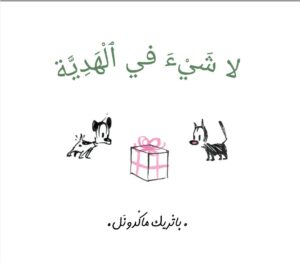 The Gift of Nothing
The Gift of Nothing 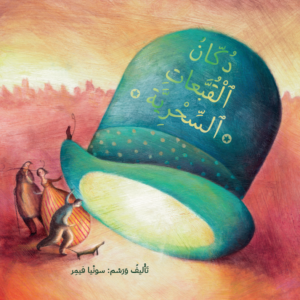 The magic hat shop
The magic hat shop 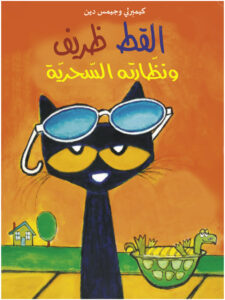 Pete the cat & his magic sunglasses
Pete the cat & his magic sunglasses 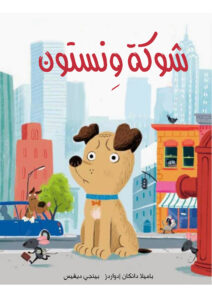 Winston was Worried
Winston was Worried  The Crow and the Peacock
The Crow and the Peacock 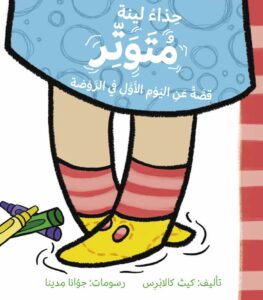 Lena’s Shoes Are Nervous
Lena’s Shoes Are Nervous 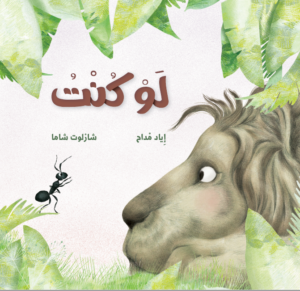 If I Were
If I Were 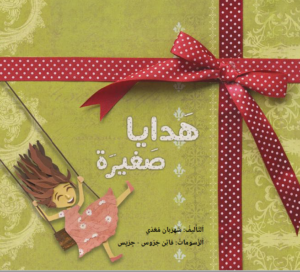 Small Presents
Small Presents 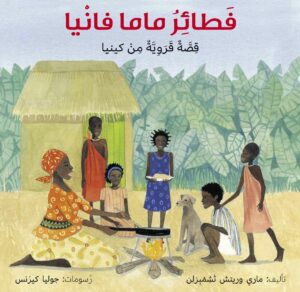 Mama Panya’s Pancakes
Mama Panya’s Pancakes 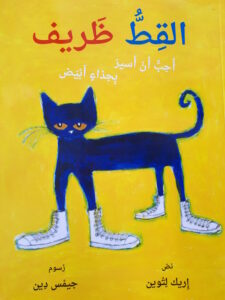 Pete the Cat- I Love My White Shoe
Pete the Cat- I Love My White Shoe 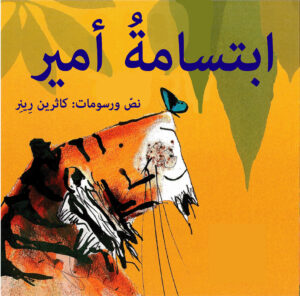 Augustus and His Smile
Augustus and His Smile 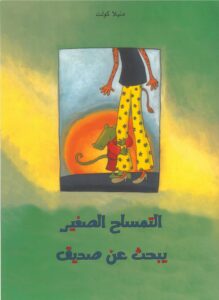 The Alligator Looks For a New Friend
The Alligator Looks For a New Friend 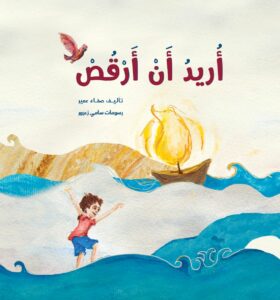 I Want to Dance
I Want to Dance 
